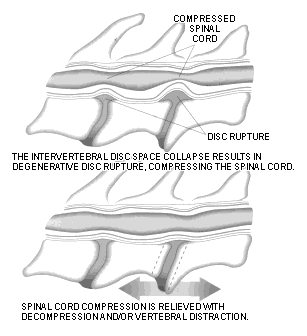What is Wobbler Syndrome
Disc associated “wobbler syndrome” is a devastating disease of the cervical vertebrae and inter-vertebral discs resulting in cervical canal narrowing and spinal cord compression, which leads to a wobbly gait/walk in dogs and horses (hence the name wobbler syndrome).
Symptoms of Wobbler Syndrome:
Initial signs of weakness and incoordination occur rapidly and are most apparent in the hindlimbs. The clinical signs worsen slowly over succeeding weeks. The hindlimbs often are spread wider apart than normal, causing the hindquarters to sway from side to side. The hindlimbs may not fully extend, causing a crouched posture with the toes scuffing on the ground with each step. The degree of forelimb involvement varies from no observable abnormality to an obvious stiffness and awkward use of the forelimbs. In mild cases, or early in the disease, these signs may be most obvious as the dog turns corners, and may be less apparent when the dog walks or runs along a straight path. An abrupt change in speed or direction may exacerbate the neurological signs.
Is my dog at risk?
This syndrome tends to affect middle aged to older, large-breed dogs (especially the Doberman Pinscher), but it is seen in small dogs as well. The truth is that this crippling condition can affect any dog, any time.
What is the cause of Wobbler Syndrome?
The underlying cause has not been completely determined yet but it seems to be a combination of disc degeneration (when the cushion between the vertebrae break down and no longer provide cushion for the vertebrae bones) and cervical spine instability.
How is this condition treated?
The best treatment for this condition is surgery; however the most common surgical procedures are invasive and associated with long post-operative recovery. In addition, they are not able to prevent the occurrence of the problem happening on another location of the spinal cord (this is called “domino lesion” and tends to occur in about 1/3 of the patients, between 6 months and 2 years after surgery”). The risk of the surgery, associated with the long post-operative period and the possibility to have the recurrence of the same problem at an adjacent vertebral space are important factors contributing to the pet-owner unwillingness to choose the surgical option.
How is an Artificial Disk Implant by Dr. Filippo Adamo different than traditional surgeries?
The treatment Dr. Adamo has designed and successfully completed in over 60 dogs within 5 years is the implantation of a metal artificial disc which keeps the vertebrae bones from rubbing against each other. Not only does this technique cure Wobbler Syndrome but it also prevents the domino lesion side effect of other traditional surgical cures. In addition this technique is minimally invasive, carries minimal risks and the canine patient is able to be released from the hospital and go home the very next day after surgery.
Cervical Disc Arthroplasty (CDA):
Cervical Disc Arthroplasty is currently the best available option in people with cervical disc disease and it is finally available for dogs with wobbler syndrome. Biomechanical and clinical studies using the 3rd generation Adamo Spinal Disc™ in dogs with wobbler syndrome showed the superiority of CDA when compared to other standard surgical techniques. Other recent clinical studies demonstrated that CDA had long term 91% success rate and no occurrence of domino lesions.
A few advantages of CDA are:
-
Less invasive, than traditional surgeries
-
Rapid post-surgical recovery
-
Can be performed on an out-patient basis (patient is able to be released from the hospital and go home the same day or the very next day after surgery).
-
Can be performed at multiple adjacent and not adjacent affected sites
-
Provide distraction/mobility at the treated sites and prevents “domino lesions”

